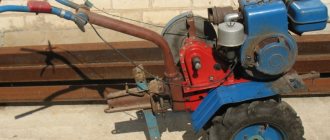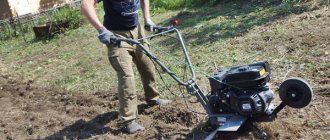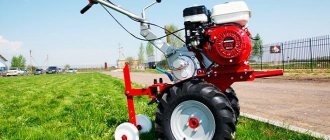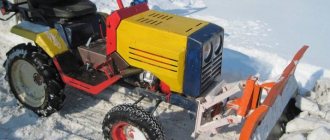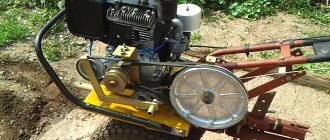The purchase of a walk-behind tractor is most often associated with seasonal cultivation of the land. Therefore, in winter these mini-tractors are usually not in demand and, as a rule, are stored in cold rooms. At the same time, the owners of such equipment will not even think about the fact that such storage significantly reduces the service life of walk-behind tractors. Fortunately, there are simple techniques that will help mini-tractors not only successfully “survive” the winter, but also work effectively during the most severe cold weather.
Preparing the walk-behind tractor for winter
Many farmers today have transferred all the most difficult work of cultivating the land to special equipment, in particular to walk-behind tractors.
With their help, you can plow the soil, make beds, plant seeds, dig up potatoes and transport them to the right place for storage. And thanks to the attached tools, the unit is capable of watering, mowing grass, removing snow, and much more. Like any other equipment, walk-behind tractors are demanding in terms of maintenance. It is very important to take care of all elements, monitor the amount of oil, and use high-quality fuel. But in addition to all this, it is also necessary to prepare walk-behind tractors for storage in winter.
Operating a walk-behind tractor in winter also requires certain actions on the part of the operator. You should not neglect them, and then the machine will serve you for a very long time and will not upset you with malfunctions.
Step-by-step instructions for starting a walk-behind tractor
After all the checks, you are convinced that the oil is filled in in sufficient quantities, gasoline or diesel fuel matches the model of your walk-behind tractor, and all fasteners and systems are in correct and working condition. Now we will tell you how to start tractor :
- gasoline behind tractor. You need to open the gasoline tap, and the choke lever should be in the “Start” position, and also turn off the ignition. After this, you need to pump the starter a couple of times, turn on the ignition, and pull the starter again. In this state the walk-behind tractor will start, and you must move the choke lever to the “Work” position. If your vehicle model has an electric starter, you can immediately turn on the ignition and start it;
- diesel walk-behind tractor. Diesel walk-behind tractors are known to be a little more difficult to start. Moreover, if you plan to work on it in winter, then you should be aware that diesel fuel tends to freeze. Therefore, you first need to warm up the equipment, and only then apply loads. So, if the unit is new, then its entire system is aired. To pump it up, you need to work with the starter. If the starter is manual, you can, of course, pull it yourself, or you can do the following procedure. Unscrew the fuel supply valve and unscrew each supply connection from it. In this case, you need to unscrew it, wait until the fuel flows and tighten it again. Continue doing this until you reach the nozzle. To manually start, open all valves and set the gas to the middle position. Hold the decompressor with your finger, squeeze it out and pump it several times. After this, release it and pull until it returns to its original position. Now press the decompressor again, and without supporting it, press the starter. The walk-behind tractor should start.
READ How to Make a Headlight on a Motoblock
As can be seen from the above, gasoline and diesel walk-behind tractors start up differently. It is important to carefully read the operating instructions and strictly follow the manufacturer's advice. You also need to use only high-quality fuel and oil that is suitable for the type of your walk-behind tractor model. And then you will not encounter problems when starting and further working on the machine.
The operation of any engine begins with its start. But the trouble is that, having made a purchase, the new owners have no idea how to start the walk-behind tractor correctly. It’s a paradox: manufacturers attach step-by-step instructions to each copy of their products, which detail the sequence of actions for operation and technical care of their brainchild, but the buyer, with tenacity worthy of better use, ignores these recommendations, believing that he already knows everything.
Preparing the walk-behind tractor for winter
Preserving a walk-behind tractor for the winter begins with careful preparation of the equipment. After the last work, you should clean and wash every part, and also inspect the entire system for breakdowns and malfunctions. The worst thing for any car is the presence of water on parts, which freezes in winter and damages the metal.
According to the instructions and safety precautions, the fuel must be completely drained, but many walk-behind tractor owners absolutely disagree with this opinion. You cannot leave the device without lubricant - the old oil must be drained and new oil refilled.
During preparation for winter, cutting elements must be cleaned of dirt and sharpened. The hinge elements also need to be thoroughly cleaned and lubricated. If you notice that the power cord is damaged, it must be replaced before canning.
In order not to encounter serious breakdowns and damage after cold weather, the walk-behind tractor must be carefully prepared for winter. This is done in several stages:
- First you need to prepare the gearbox and motor. It is necessary to drain the old oil and fill in new oil. You can also use old oil, but it should still be in good condition. It is carefully filtered and poured into the system. After winter, the oil is still completely replaced with new one, since it deteriorates when standing and in the cold;
- Unscrew the spark plugs, fill in about 2 cm of oil, and turn the crankshaft a little;
- Air filters need to be cleaned thoroughly. If they are in an oil bath, they need to be filled with new engine oil;
- If you have an electric starter in your walk-behind tractor, the battery for it should be stored exclusively in a warm room. Charge it periodically during the winter;
- All attachments, as mentioned above, need to be cleaned, lubricated with oil, and the cutting parts sharpened;
- Many owners coat all painted parts of walk-behind tractors with a special polish to protect them from rotting. It is important to thoroughly clean the product from dirt and dust before doing this.
Features of launching some models of walk-behind tractors
Different models of walk-behind tractors start in different ways. In order not to encounter difficulties, you should carefully read the instructions, where everything will be described in detail.
So, to start Neva walk-behind tractor After this, you open the gasoline valve and close the choke valve. The throttle should be at approximately ¾ of the maximum setting. Pull the starter and then open the choke. If you start the walk-behind tractor in the cold season, then you need to open the damper gradually.
The Ural walk-behind tractor starts up quite simply too. The gear shift knob should be in neutral and the gas tank should be open. Then close the throttle and choke, and then start the engine.
The Patriot unit starts up in this way. The throttle should be in the maximum position. You need to pull the cord a couple of times to purge, and then a few more times, but sharply and briefly, to start the motor. Rotate the throttle to adjust it.
Is it necessary to drain gasoline from a walk-behind tractor for the winter?
The fuel tank is carefully prepared for winter. This is where the opinions of experts differ: some say that you need to dry the tank by completely draining the fuel, while others, on the contrary, advise filling it completely.
In the first case, corrosion may still appear, because it may turn out that you have not completely dried the fuel tank. However, if it is filled completely with fuel, as in the second option, then the likelihood of a fire increases, and this is a much more serious and dangerous problem. We recommend that you follow the instructions and not risk your life or your property.
Preparation of units with four-stroke engines
In this case, special attention should be paid to the gas tank.
Ways to prepare this equipment for winter:
- Fill the gas tank with fuel with the addition of a special additive. This is done to ensure that the fuel does not separate during storage. Using this method, you can be sure that during cold storage no condensation will form inside the gas tank.
- Empty the tank. Having settled on this method, it is necessary to treat the internal surfaces of the gas tank, intake manifold and cylinders with agents that prevent oxidation. Before wintering, the oil from the collector should be drained to avoid the formation of sediment and loss of its properties.
- Safety of hoses and wires
Over the winter, wires and hoses can oxidize or lose their elasticity. To avoid this, it is recommended to use aerosols containing wax and silicone. Their convenience is that after wintering there is no need to remove the coating from the surfaces before putting the equipment into operation.
To ensure the safety of wheels and tires during long-term storage, it is recommended to remove them from the equipment or install the equipment on special stands. Additionally, do not forget about the storage temperature specified by the rubber manufacturer.
- Temperature and humidity
Rubber seals, oil seals and rings are most susceptible to temperature fluctuations and changes in humidity. The main danger is moisture, which in the form of condensation penetrates into the moving parts of equipment, freezes in them, and, expanding, causes mechanical damage.
How to start a walk-behind tractor in winter?
Motoblocks are universal equipment that can be actively used even in winter. With its help, or rather with the help of such attachments as a snow blower, you can clear snow on your garden plot. But there may be some difficulties with starting the engine at low ambient temperatures, but there is always a way out.
We offer you some tips that will help you actively use your walk-behind tractor in winter:
- Modern models of this technology are produced with air cooling. This greatly simplifies the process of operation at sub-zero temperatures - you do not need to add antifreeze and constantly monitor the operation of the radiator, which has a water cooling type. However, there is a minus here - in winter the engine will cool down faster;
- On sale you can find special insulating covers for the unit that protect the engine from rapid cooling, but they are extremely rare. You can make do with improvised materials, but at the same time be careful that the insulation does not get into the mechanisms and damage the system;
- To start the engine in winter, sometimes you need to prepare it, namely, preheat it. To do this, the engine itself must be watered with hot water so that it reaches a condition for normal starting;
- Don't forget about the oil in the gearbox. As you know, it thickens at sub-zero temperatures. There are two options here: use synthetic types that retain their properties better in winter, or use a more liquid one.
General rules for storing gasoline equipment
There are several general rules for preparing gasoline equipment for winter storage, regardless of their performance and technical design, which may differ.
Common procedures include:
- Unit operation cycle using a cleaning additive
This is necessary in order to clean the fuel system elements and the engine from deposits and carbon deposits that accumulate over the season of using the equipment. If you neglect this point, combustion products can become embedded and remain in the base of the fuel system forever.
- Clean and shiny
Before preparing for conservation from the technical side, the equipment must be cleaned and washed. Organics and soil or sand destroy mechanisms and provoke oxidation.
- Equipment with single-stroke engines. Preparation and canning
The first step in preparing the unit is draining the fuel. For this type of equipment, the fuel is an oil-fuel mixture. After two weeks of storage, it divides into layers and becomes unsuitable for engine operation.
To protect the internal walls of the cylinder, it is necessary to fill it with oil (the main thing is to remember to drain it before using the unit next season). This method will help protect the engine from corrosion. The cleaned carburetor should be coated with a special composition that resists corrosion.
How to start a walk-behind tractor in winter - tips for beginners
The advantages of a modern walk-behind tractor are its versatility and high performance. Provided that the appropriate attachments are available, the unit available on the farm can be actively used in winter - for clearing large amounts of snow and solving other household tasks.
At the same time, improper operation of the walk-behind tractor in winter, and especially its incorrect starting, significantly reduces the working life of the main mechanisms of the unit. What should you do to avoid common mistakes when starting a “cold” walk-behind tractor?
First of all, you will need to understand the type of cooling system provided in its design. Units equipped with an air system are easier to store and start up in winter - they do not require quickly freezing antifreeze and constant checking of the radiator. At the same time, the air cooling system also has its drawback - the engine with it heats up faster, which means it cools down faster, which will not allow you to take long breaks when working in winter.
Many walk-behind tractors require preliminary insulation of their engines to operate in winter. For this purpose, both branded covers and various improvised means can be used - blankets, rugs and other fabric products. It is especially important to ensure high-quality insulation in severe frost conditions, down to -20 ⁰C. If the temperature does not drop below 5–10 ⁰C, then this step can be skipped.
The place in which the walk-behind tractor is stored also plays an important role. If the unit is planned to be actively used in winter, then it is best to choose a heated room for this - a garage or other domestic building.
When using a walk-behind tractor intensively in winter, it is extremely important to take care of the oil poured into the gearbox. Synthetic oils are better for use in winter, since at sub-zero temperatures they retain their most important properties longer than mineral oils. In any case, it is best to use thinner oils that do not thicken so quickly in the cold.
By following all these rules, the owner of the walk-behind tractor will be able to easily start his unit. Starting an agricultural machine in winter is carried out in the same sequence as at any other time of the year. The only difference is to let the walk-behind tractor idle for at least 15 minutes - during this time its engine will warm up and be completely ready for work. More details about starting a walk-behind tractor in winter can be found in the video.
Long-term storage of walk-behind tractor
Preservation of equipment begins with its thorough cleaning. Particular attention should be paid to hard-to-reach places where pollution accumulates. When removing dirt from the surface of the product, it is not recommended to use iron scrapers, because they damage the protective coating, which leads to rust. After cleaning, all parts of the walk-behind tractor (motor-cultivator) must be wiped dry. There should be no moisture remaining on the surface of the product to avoid corrosion. The same thorough cleaning is required for attachments.
Then you need to inspect the walk-behind tractor (cultivator) for damage and breakdowns. If parts that have become unusable are found, they should be replaced. If you have experience, you can do this yourself or contact a service center.
Walk-behind tractor storage
Walk-behind tractor maintenance
Preparing a walk-behind tractor for winter - what should you take care of?
Proper preservation of a walk-behind tractor for the winter is an important topic that allows, if not extending, then at least preserving the working life of the unit used on the farm. The preparation of an agricultural machine itself is not a complicated procedure. It is enough to study a number of rules and tips that will help you maintain your walk-behind tractor and start it without problems after wintering.
When sending the unit for winter storage, you will need:
- Completely replace the oils in the engine and gearbox of the unit. To do this, you will need to fill the appropriate tanks with a new lubricant for the winter, or, in extreme cases, filter out the old one, making sure that there is no sediment in it. In any case, with the onset of spring, the oil will need to be replaced;
- Wash all the filters in the walk-behind tractor. If the unit is equipped with filters placed in an oil bath, then they will need to be filled with fresh engine oil;
- Many experienced farmers recommend unscrewing the spark plugs of the walk-behind tractor before winter storage, then pouring no more than 20 ml of engine oil into the working cylinder, and manually turning the crankshaft of the unit, performing just a few revolutions;
- For the winter, the walk-behind tractor must be washed from dirt, not missing parts located in hard-to-reach places. After washing, you will need to apply a thick layer of oil to the body and spare parts of the unit, which will help prevent the formation of corrosion;
- if possible, instead of oil, a special polish with a protective function can be applied to the parts of the walk-behind tractor - it forms a durable film on the metal surface that will prevent the metal from rotting in winter. In this case, it is very important to apply the product to a clean surface, since otherwise it will not protect the metal parts of the walk-behind tractor;
- All spark plug caps and electrical connectors of the unit should be lubricated with silicone grease in the form of a spray for the winter - it will effectively protect them from exposure to various environmental factors;
- If the walk-behind tractor is designed with an electric starter, then while storing it in winter it is best to remove the battery from the unit and move it to a dry and warm room. The battery will need to be fully charged several times during storage;
Why the walk-behind tractor won't start - let's understand the reasons
Before the start of the season, both gasoline and diesel walk-behind tractors need preparation. To do this, the owner of the unit must make sure that the design of the unit contains all the parts necessary for operation, and each of them “sits” tightly in its normal place.
Often, many walk-behind tractors equipped with a Subaru engine or engines of other well-known brands refuse to work after a long winter period of inactivity. At the same time, incorrectly chosen storage conditions for an agricultural machine also have an effect - if it has been standing in a cold, damp room, then, most likely, it will not start before the start of spring work. This is due to a number of malfunctions:
- Oxidation of contacts in electrical wiring;
- Violation of the integrity of the wiring insulation;
- Watering of oil and fuel;
- Accumulation of debris in the carburetor jets.
Before starting a walk-behind tractor, its owner must carefully inspect all the connections in the design of the unit. You need to check the movement of the throttle, reverse and clutch cables - it should be soft. If during inspection you find clamps or twisted cables, then you cannot start the walk-behind tractor.
Before starting the walk-behind tractor for the first time, you should check the oil level inside the crankcase. If the lubricant is missing, this will lead to severe damage to the piston group. Judge for yourself: at a crankshaft rotation speed of 1400 rpm, a split second will be enough for it to form several burrs on the surface of the cylinder.
Oil left over for the winter is one of the main reasons for unstable operation of the unit’s motor. It is quite simple to make sure that the walk-behind tractor is difficult to start for this very reason - after starting, white smoke will pour out of the exhaust pipe of the machine for a few seconds, after which the unit will stall. Do not forget that both diesel and gasoline walk-behind tractors have difficulty starting due to insufficient oil. Some models of units are equipped with low level protection; owners of other machines should independently monitor the volume of oil inside the tank.
Another important factor is the gasoline you use to refuel your walk-behind tractor. If you regularly fill up with fuel of a different brand than that recommended by the car manufacturer, this may also cause the car to not start.
This is interesting: Types of rakes for walk-behind tractors: do it yourself, drawings and dimensions
Is it necessary to drain gasoline from a walk-behind tractor for the winter?
There is a lot of controversy about whether it is necessary to drain gasoline during the winter storage of a walk-behind tractor. Some farmers advise storing the unit without fuel, others have a completely opposite opinion.
In fact, it all depends on the type of fuel consumed. If the farm uses a diesel walk-behind tractor, then not everyone can store it in very severe frosts with fuel in the tank. This is primarily due to the property of diesel to freeze already at -10 ⁰C. To avoid this, various additives can be poured into the diesel fuel tank to prevent the fuel from freezing. At the same time, even the most effective additives are not able to maintain the liquid state of diesel at temperatures from -25 ⁰C and below. Therefore, if the winter in the region is very cold, then before storage it is best to drain all the fuel from the diesel walk-behind tractor.
The situation is completely different with gasoline walk-behind tractors. Most experts are inclined to believe that such units are best stored with a full tank of fuel. This will help prevent corrosion from forming on the inner surface of the fuel tank walls. It is extremely important to fill the tank completely, otherwise rust may form on the walls in the empty part of the tank.
Preparatory stage
After this, you need to add fuel. In the operating instructions you will find information about which gasoline is suitable for your model of walk-behind tractor. You can also check this information with sellers. Another important point concerns two-stroke engines, where gasoline must be diluted with oil in a certain proportion.
Only after this can you proceed directly to inspecting the entire walk-behind tractor. That is, you must check all connections, steering wheel and wheel fastenings, clutch and gas cables, and so on.
Why is it necessary to preserve?
Under no circumstances should you simply leave a walk-behind tractor in a cold garage until it warms up. It is necessary to preserve and store it carefully and correctly. In the worst case, after the snow melts, you simply will not be able to start the unit. Simple recommendations for storing a walk-behind tractor in winter will help you avoid mistakes in this matter.
- Pay attention first of all to the motor with gearbox. We change the oil - the previous one can also be used, but only if it is in good condition and filtered.
- We conscientiously clean the air filters and fill the engine oil.
- We unscrew the spark plugs, add oil to the cylinder (about 20 ml) and “manually” turn the crankshaft (literally a couple of revolutions).
- We carefully clean all parts of the walk-behind tractor from the accumulation of dust and dirt (do not forget about the most inaccessible places). Next, we coat the body and spare parts of the special equipment with a thick layer of oil, which will protect against corrosion. We sharpen sharp edges.
- If the walk-behind tractor is equipped with an electric starter, then remove the battery during winter storage. And also don’t forget about charging it regularly throughout the “frost period”.
- We cover the unit, or rather its painted parts, with polish. This will help protect the product from rotting. It should be noted that we apply polish only to a clean unit, otherwise it will not provide any help. With the onset of spring, the coating layer should be washed off.
- Don’t forget to open the vehicle’s fuel supply valve a couple of times a month and pull the starter handle 2-3 times.
General rules for equipment conservation
Any tool, regardless of type and purpose, must be washed, dried and parts inspected for wear and replacement before storing. There is nothing worse than moisture getting into moving or vulnerable parts and mechanisms. Freezing in an unheated room, it turns into ice and damages the elements of the system. For fire safety reasons, it is also advisable to drain the gasoline from the gas tank. But there are other recommendations regarding oil - equipment cannot be left “dry”, so in the winter the oil is not removed, but replaced.
When storing, fold the equipment as indicated in the instruction manual
Cutting parts (such as lawn mower blades) should be sharpened, and hinge joints should be cleaned of dust and dirt and lubricated. Check the condition of the fasteners and power cord of the power tool, if necessary, replace them without leaving them until spring. Next, we will consider each type of equipment and the requirements for its conservation in more detail.
Operating equipment in cold weather
Motoblocks are widely used in the cold season. A motor cultivator with a 4-stroke gasoline (or diesel) engine can handle snow removal.
The universal unit is capable of performing the following functions in winter:
- acts as an additional source of electricity (power adapter);
- indispensable for procurement work (garbage removal, firewood collection);
- removes snow from the territory;
- a vehicle for fishing in winter, and the trailer will serve as a storage place for fishing rods, a tent and a sleeping bag.
Many people wonder whether it is necessary to heat the oil in order to take the unit on winter fishing. The process of heating the engine is necessary when turning on the walk-behind tractor in the cold. So, let's look at the features of turning on the unit in winter.
- Modern walk-behind tractors require cooling (air). This simplifies their operation at sub-zero temperatures. However, the disadvantage is that the engine cools quickly in winter.
- There are special insulation covers for walk-behind tractors. This will help maintain the “right” temperature.
- In winter, the engine must be preheated (by diligently pouring hot water).
- Gearbox oil tends to thicken at low temperatures. Therefore, it is best to use its synthetic types or a rather liquid structure.
Starting gasoline and diesel units
The walk-behind tractor is a multifunctional tool. It is indispensable for running a household plot. Attachments allow you to perform land cultivation, grass mowing, snow removal, cargo transportation, planting and harvesting.
The equipment is equipped with gasoline or diesel engines. There are differences between starting a diesel walk-behind tractor and a gasoline unit. Therefore, the reasons why the walk-behind tractor does not start should be analyzed for each specific engine type.
Before starting the walk-behind tractor, the equipment is prepared. You need to make sure that all parts are present and that the mechanisms are securely fastened.
Mechanisms often stop working after winter. A long break causes malfunction of the walk-behind tractor systems. Storage in a cold and damp room leads to the following damage:
- Oxidation of contacts.
- Violation of wire insulation.
- Watering of fuel and oil.
- Carburetor jets clogged.
Before starting a new walk-behind tractor, all connections, clutch cable, reverse and throttle are checked. The movement of the cables should be smooth and effortless. Do not start the unit if there are clamps and twists in the harness threads.
During the first start, be sure to check the oil level in the crankcase. Lack of lubrication will damage the piston group. The crankshaft rotates up to 1400 rpm at idle. A couple of seconds is enough for a scuff to form on the surface of the cylinder.
Old oil can cause engine failure. At the same time, the walk-behind tractor smokes white exhaust gases. A complete oil change suggests itself.
It should be taken into account that the walk-behind tractor does not start well if there is insufficient oil volume. Keep an eye on this parameter before starting a carburetor and diesel walk-behind tractor. On some models, protection is set to a low level. The sensor blocks the start and the unit stalls.
It should be remembered that each type of engine requires a certain brand of gasoline. For a two-stroke engine, fuel is prepared separately. The fuel mixture consists of gasoline and oil. The amount of ingredients is kept in strict proportions.
https://youtube.com/watch?v=a4riTb38tNk
Purchase gasoline for walk-behind tractors at gas stations. The service life of vehicles directly depends on the quality of fuel. You should not start the walk-behind tractor on bad gasoline.
This is interesting: Features of making a gearbox for a walk-behind tractor with your own hands - we consider it point by point
How to make a snowmobile?
Buying a vehicle through snowdrifts is an expensive business. There is an exit! A simple and affordable solution would be to convert the unit into a snowmobile. Such a unit will “cope” with fast driving in snow and mud (in spring).
When designing a homemade all-terrain vehicle, we pay attention to the wheeled chassis. When creating an all-wheel drive “beast,” you need to attach sprockets to the axles and connect them with a chain. A conveyor belt is suitable for tracks.
Ideally, it is better to purchase ready-made chassis (modular). “Winter wheels” should be wide and have a large diameter.
The frame, which can be placed on an all-terrain vehicle, is made of steel angle. The weight of the trailer must not outweigh the body of the tractor.
Most walk-behind tractors are suitable for working with all types of snow clearing equipment. One of the options for using a motor cultivator involves attaching a rotary snow blower. This device is excellent at clearing snow using spiral shears. Snowdrifts “fly away” at a distance of up to 7 meters. The device's grip ranges from 60 to 120 cm.
How to prepare special equipment for the coming season?
After the unit has safely “survived” the winter period, we begin to prepare it for the new season and loads. This procedure is divided into several stages.
- We are replacing the fuel. We drain the remaining gasoline and add new one. In winter, gasoline could turn sour.
- Let's check the spark plug. Its position must be stable, without air access.
- Open the fuel tap.
- Keep the air gap lever closed until the engine warms up.
- We set the ignition to the “on” mode.
- Pull the starter handle. As soon as we feel “resistance”, we make a sharp movement “towards ourselves”.
- We are not afraid of smoke. It is released when oil burns.
If you notice significant problems in the operation of the walk-behind tractor after winter storage, contact a specialist.
For the rules for preserving a walk-behind tractor for the winter, see below.
Preparatory stage
After this, you need to add fuel. In the operating instructions you will find information about which gasoline is suitable for your model of walk-behind tractor. You can also check this information with sellers. Another important point concerns two-stroke engines, where gasoline must be diluted with oil in a certain proportion.
Only after this can you proceed directly to inspecting the entire walk-behind tractor. That is, you must check all connections, steering wheel and wheel fastenings, clutch and gas cables, and so on.


